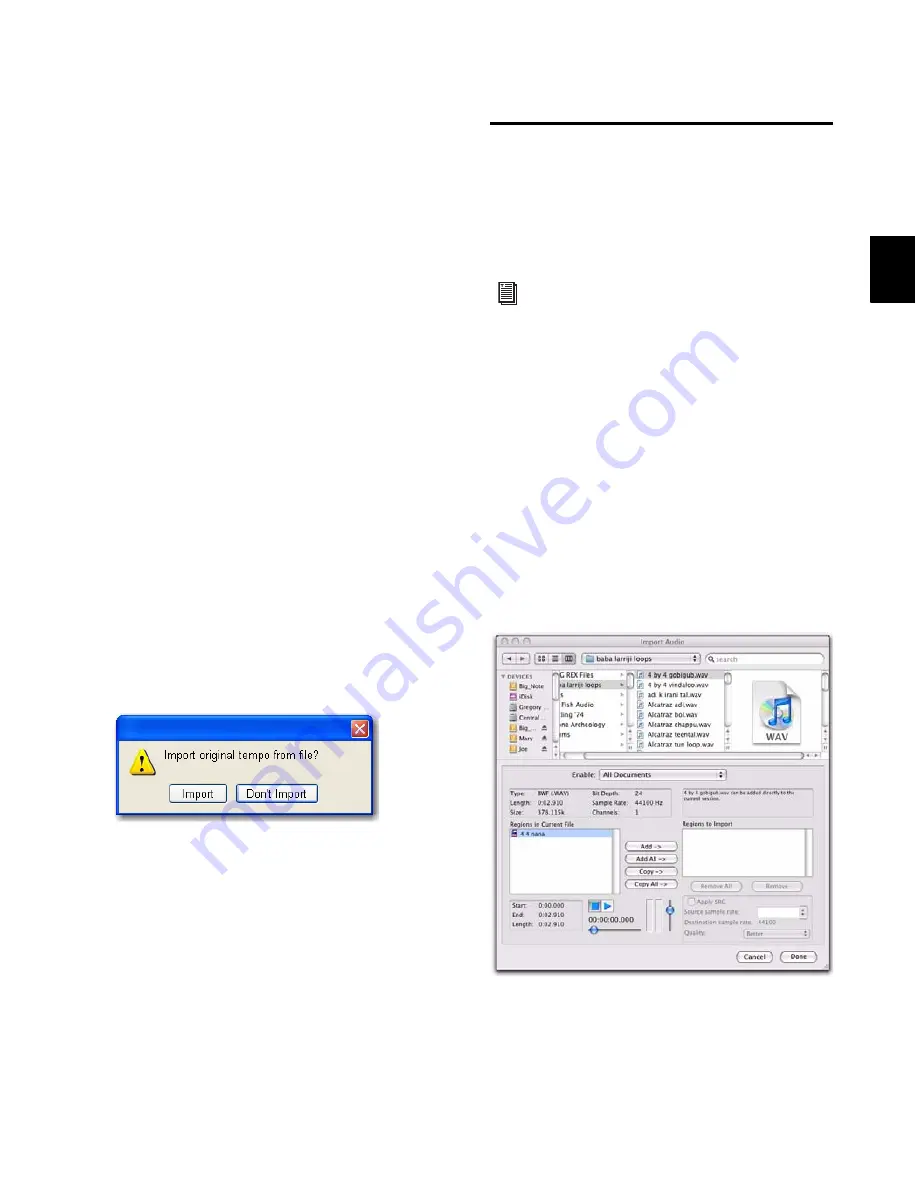
Chapter 15: Importing and Exporting Session Data
283
tick-based Elastic Audio depending on the
Drag
and Drop from Desktop Conforms to Session
Tempo
preference (see “Drag and Drop From
Desktop Conforms to Session Tempo” on
page 279).
Importing Elastic Audio from DigiBase
to the Region List
With the
Audio Files Conform to Session Tempo
option enabled, dragging and dropping tick-
based audio from DigiBase browsers to the Re-
gion List (or to the Track List), creates two sepa-
rate regions in the Region List. The first is a sam-
ple-based whole file region and the second is a
tick-based copy of the same region.
Importing Tempo from Tick-Based Audio
If there are no tracks in the session, and you im-
port a tick-based audio file to the Region List,
Track List, or empty space in the Edit window,
you are prompted to either import the tempo
from the file or use the default session tempo. To
keep the default session tempo, and have the
loop conform to the session tempo, click
Don’t
Import
.
If the session already contains at least one track
(regardless of track type), you are not prompted
to import the tempo from the file and the file is
conformed to the session tempo.
Importing Audio Files and
Regions Using the Import
Audio Command
The
Import Audio
command lets you import au-
dio files or regions into your Pro Tools session.
To import audio files or regions into a session
using the Import Audio command:
1
Choose
File > Import > Audio
.
2
In the Import Audio dialog, locate and select
an audio file to display its properties and associ-
ated regions.
You can choose to display only a certain file
type (such as AIFF) by selecting the type from
the
Show
pop-up menu. To display all supported
file types, select
All Documents
from the
Show
pop-up menu.
Import Original Tempo From File
To import entire tracks from other sessions,
see “Importing Session Data” on page 289.
Figure 18. Import Audio dialog
Summary of Contents for Digidesign Pro Tools 8.0
Page 1: ...Reference Guide Pro Tools 8 0 ...
Page 18: ...Pro Tools Reference Guide xviii ...
Page 19: ...1 Part I Introduction ...
Page 20: ...2 ...
Page 24: ...Pro Tools Reference Guide 6 ...
Page 40: ...Pro Tools Reference Guide 22 ...
Page 45: ...27 Part II System Configuration ...
Page 46: ...28 ...
Page 58: ...Pro Tools Reference Guide 40 ...
Page 76: ...Pro Tools Reference Guide 58 ...
Page 118: ...Pro Tools Reference Guide 100 ...
Page 127: ...109 Part III Sessions Tracks ...
Page 128: ...110 ...
Page 144: ...Pro Tools Reference Guide 126 ...
Page 170: ...Pro Tools Reference Guide 152 ...
Page 228: ...Pro Tools Reference Guide 210 ...
Page 292: ...Pro Tools Reference Guide 274 ...
Page 343: ...325 Part IV Playback and Recording ...
Page 344: ...326 ...
Page 386: ...Pro Tools Reference Guide 368 ...
Page 442: ...Pro Tools Reference Guide 424 ...
Page 443: ...425 Part V Editing ...
Page 444: ...426 ...
Page 490: ...Pro Tools Reference Guide 472 ...
Page 528: ...Pro Tools Reference Guide 510 ...
Page 566: ...Pro Tools Reference Guide 548 ...
Page 590: ...Pro Tools Reference Guide 572 ...
Page 591: ...573 Part VI MIDI ...
Page 592: ...574 ...
Page 648: ...Pro Tools Reference Guide 630 ...
Page 670: ...Pro Tools Reference Guide 652 ...
Page 679: ...661 Part VII Arranging ...
Page 680: ...662 ...
Page 756: ...Pro Tools Reference Guide 738 ...
Page 769: ...751 Part VIII Processing ...
Page 770: ...752 ...
Page 780: ...Pro Tools Reference Guide 762 ...
Page 786: ...Pro Tools Reference Guide 768 Figure 3 Quantized audio events Warp markers in Warp view ...
Page 814: ...Pro Tools Reference Guide 796 ...
Page 842: ...Pro Tools Reference Guide 824 ...
Page 843: ...825 Part IX Mixing ...
Page 844: ...826 ...
Page 976: ...Pro Tools Reference Guide 958 ...
Page 991: ...973 Part X Surround ...
Page 992: ...974 ...
Page 1000: ...Pro Tools Reference Guide 982 ...
Page 1025: ...1007 Part XI Sync and Video ...
Page 1026: ...1008 ...
Page 1080: ...Pro Tools Reference Guide 1062 ...
Page 1111: ......
















































